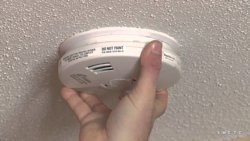There is approx. 24, 000 house fires each year in Canada, 1 out of 100 preventable house fires are fatal. Most common places for residential fires to start are in bedrooms, kitchen, and living rooms. Lastly, in fatal preventable house fires, more than 1/3 of homes didn’t have a working smoke detector. Which is why it is so important smoke/co2 detectors are properly tested ensuring they are in good working order when you need them the most. Here are proper techniques for testing these alarms;
Smoke Detectors:
- Low Batteries: If your alarm is chirping during the wee hours of the morning, chances are the batteries are running low. Perform a test, by simply pressing the “test” button. After a few seconds you should hear a loud piercing siren, if not you need to change the batteries. Don’t assume the batteries are fine if you don’t hear chirping during the day, cooler temperatures are harder on batteries than the warmer clime of the day. To ensure your smoke detectors are at work at at every hour, you’ll need to test the batteries. One big misunderstanding is why hard wired smoke detectors are chirping, most don’t realize that although a smoke detector my be hard wired, they will still contain a battery as back up in the event the power goes out. So you will still need to replace the battery and test the alarm as mentioned above in the event your alarm is chirping.
- Detecting Smoke: The “test” button on the device is only designed to test whether the batteries are working. So to take the extra step to ensure your alarm is working, is to test whether it detects smoke. For some of us, we unintentionally test our devices every time we enter the kitchen to cook. But for those who are better at cooking can take the step, of lighting a candle and holding it approx. a foot from the detector; if you hear alarms, your device is working!
Carbon Monoxide Detectors:
Testing your carbon monoxide detector will be a very similar process as the smoke detectors. However, since you will obviously not release carbon monoxide into your home, you can’t test much past the batteries. Prior to testing your carbon monoxide detector, we recommend notifying your home security company and place your detector into “test mode” Once this is complete, hold down the “test” button until you hear 2 beeps. Release for a moment, then press down again until you hear 4 beeps. That’s it! After approx. 10-15 minutes, your carbon monoxide alarm will return from test mode to original setting.
Although the light may be steadily on, it is still extremely important to test your smoke and carbon monoxide detectors regularly. We recommend once a month for testing and every quarter changing out your batteries. Following these steps can help save your life if a fire strikes.
If your devices don’t pass the testing or you are concerned Contact Us! right away.
Tags: carbon monoxide, Certified Electrician, edmonton electrical, electrical contractors edmonton, Electrical Safety, St.Albert Electrician
